#Friedrich Schneider
Photo



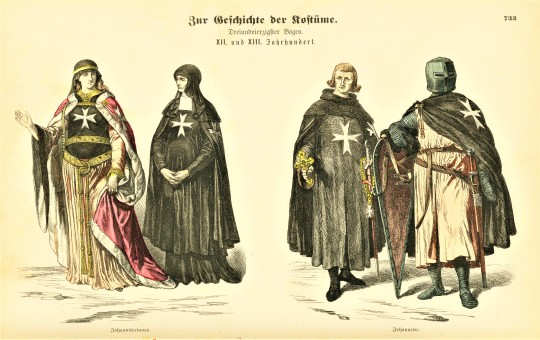




Fashion Friday: Liturgical Looks
This lapsed Catholic realizes that not all the above looks from Munich publishers Braun & Schneider’s Zur Geschichte der Kostüme are liturgical, strictly speaking, but I couldn’t resist the allure of an alliterative title. Church chic doesn’t quite have the same ring to it! These plates originally appeared as illustrations for the biweekly single-leaf publication Münchener Bilderbogen, published in Munich by Braun & Schneider from 1848-1898. The publishing firm also produced fifty annual volumes collecting the previous year’s output. The publication covered a wide range of topics including comic drawings of animals, humorous stories, cautionary tales, and illustrated fairy tales.
It is unclear when this volume of plates illustrating both historical and contemporary regional fashion trends was produced. The publishers started producing bound collections of their fashion plates as early as 1874, but it is likely this particular collection is from after 1898, as some of the plates are from the final annual Münchener Bilderbogen. The plates from Zur Geschichte der Kostüme were reproduced again in 1975 by Dover Publications under the title Historic Costume in Pictures, with Braun & Schneider credited as authors. As explained in a publisher’s note in that book, Dover decided to reproduce the plates in black and white because there is so much variation in color between the various remaining copies. This is confirmed by our own holdings: Special Collections has three copies of Zur Geschichte der Kostüme, all seemingly containing the same plates (though one is missing its index), and all lacking publication dates. Note the variations between the first plate in each volume:


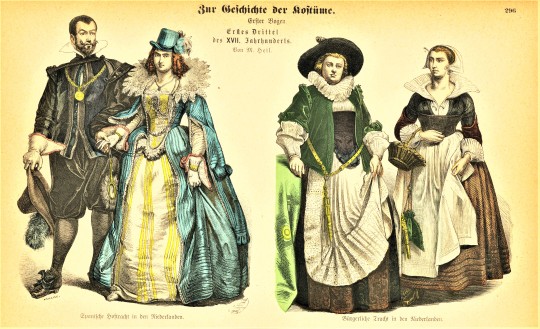
While German painter Louis Braun is credited as the lead artist for the collection in our catalog record, it is unclear if he contributed to any of these images, though the Crusaders (images 4 & 5) bear only the name “Cehric,” who the Library of Congress identifies as an engraver. Also unclear is whether Louis Braun is related to Kaspar Braun, of Braun & Schneider. The artist of images 6 & 7 is identified as M. Adamo, likely Max Adamo, brother of frequent Münchener Bilderbogen contributor Albert Adamo. A. Müller, (the artist of images 1-3 & 8) refers to the Düsseldorf-based painter Andreas Müller.
Check out our previous post on Zur Geschichte der Kostüme here.
Find more Fashion Friday posts here.
-Olivia, Special Collections graduate intern
#Fashion Friday#Zur Geschichte der Kostüme#Münchener Bilderbogen#History of Costume#Braun & Schneider#Kaspar Braun#Friedrich Schneider#Louis Braun#Cehric#Max Adamo#Albert Adamo#Andreas Müller#Munich#Munich publishers#Historical Fashion#Crusades#Monks#Liturgical Garb#olivia
88 notes
·
View notes
Text
youtube
Friedrich Schneider (1786-1853) - Das Weltgericht, Op. 46, Teil 1 "Der Tod": No. 4, Verworfne, schweigt ·
Joachim Holzhey · Camerata Lipsiensis · Gregor Meyer
2 notes
·
View notes
Text



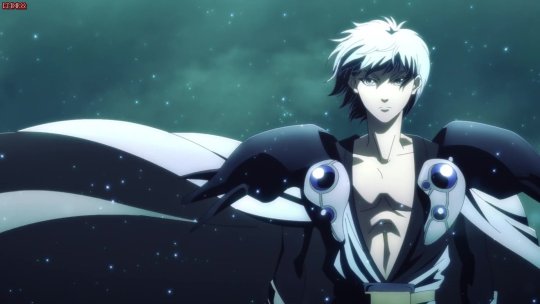
Bastard!! (OP) Parte 2
#bastard!!#dark schneider#kall su#tia noto yoko#kai harn#joshua belaira#vai staebe#schen karr#jorg fishes#yngwie von mattstrom#zion sol vanderverg#maclalpine toni strauss#shella e lee#ran di rhodes shutein neubauten#bol gil bol#ross zaboss friedrich#zakk walder#sykes von snowwhite#ida deesna#ba thory#vlad kills#bastard ankoku no hakaishin
5 notes
·
View notes
Photo
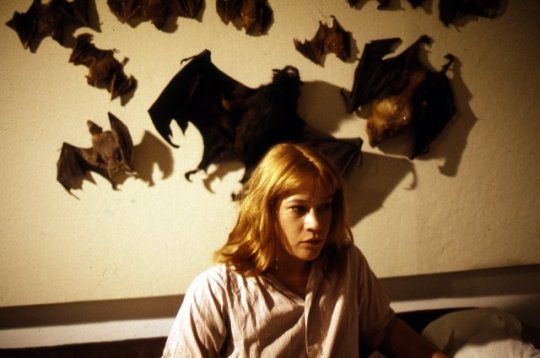
The Second Awakening of Christa Klages (Das zweite Erwachen der Christa Klages), Margarethe von Trotta (1978)
#Margarethe von Trotta#Luisa Francia#Tina Engel#Silvia Reize#Katharina Thalbach#Marius Müller Westernhagen#Peter Schneider#Ulrich von Dobschütz#Erika Wackernagel#Friedrich Kaiser#Achim Krausz#Franz Rath#Klaus Doldinger#Annette Dorn#1978#woman director
21 notes
·
View notes
Photo

Bad movie I have Schindler’s List 1993
#Schindler’s List#Amblin Entertainment#Liam Neeson#Ben Kingsley#Ralph Fiennes#Caroline Goodall#Jonathan Sagall#Embeth Davidtz#Malgorzata Gebel#Shmuel Levy#Mark Ivanir#Béatrice Macola#Andrzej Seweryn#Friedrich von Thun#Krzysztof Luft#Harry Nehring#Norbert Weisser#Adi Nitzan#Michael Schneider#Miri Fabian#Anna Mucha#Albert Misak#Michael Gordon#Aldona Grochal#Jacek Wójcicki#Beata Paluch#Piotr Polk#Ezra Dagan#Beata Deskur#Rami Heuberger
0 notes
Text
academic papers about black sails
Jones, Clint, "Black Sails as Philosophy: Pirates and Political Discourse"
Myrvang, Olav Kjetil, "Because I don’t want to be a pirate" - A Contextual Study of the Representation of Long John Silver in Treasure Island and Black Sails
Carcas, Leyres, “HETEROBAITING”: BLACK SAILS AND THE SUBVERSION OF QUEERBAITING TROPES
Schneider, Elisabeth, "RECLAIMING QUEERBAITING: A CALL TO ACTION"
Friedrich, Kathrin, "‘Evil Heroes’ in Black Sails – A Case Study: How Character Complexity and Nonverbal Actions Invite Positive Viewer Responses"
Razman, D. C. (2020) “Black Sails, Rainbow Flag: Examining Queer Representations in Film and Television” [click for pdf]
Srividhya Swaminathan, (2017) “The New Cinematic Piracy: Crossbones and Black Sails” (in ‘The Cinematic Eighteen Century: History, Culture, and Adaptation’ (2017, 1st ed.) edited by Srividhya Swaminathan and Steven W. Thomas)
Dirksen, S.J. (2019) “Constructing the Identity of the Popular Pirate: The Outlaw, Marginal Identities, and Utopia in Black Sails (2014-2017) and Assassin’s Creed IV: Black Flag (2013)”
Min-Chi Chen (2024) “Weaponizing Monstrosity: Starz’s Black Sails and the Power of Monstrous Narrative” (in Chapter 2 of ‘Monsters and Monstrosity in Media: Reflections on Vulnerability’, 23, 2024, edited by Yeojin Kim, Shane Carreon)
Jessica Walker “Civilization’s Monsters: The Doomed Queer Anti-Imperialism of Black Sails” (in ‘Pirates in History and Popular Culture’ (2018) edited by Antonio Sanna) [entire book in pdf]
“From Dogs to Kings” https://www.diva-portal.org/smash/get/diva2:1332062/FULLTEXT01.pdf
928 notes
·
View notes
Text
Mrs. Goebbels said to the children: "Children, don't be afraid, the doctor will now give you an injection that all children and soldiers will now receive." With these words she left the room.
8:40 p.m. (on May 1st). After 10 minutes, Ms. Goebbels, accompanied by me, went into the children's room, where she stayed for about five minutes and placed a crushed ampoule of cyanide in each child's mouth. (Each glass ampoule contained 1.5 cm high 3 cyanide.) When we returned to the anteroom, she said: "Now it's all over."
Then I went with her down to Goebbels' study, where we found him pacing up and down the room in a very nervous state. As she entered the study, Mrs. Goebbels said: "It's over with the children, now we have to think about ourselves." Goebbels replied: "We have to hurry, because we have very little time." Then Mrs. Goebbels said: "Here in the We don't want to die in the bunker," and Goebbels added: "It's clear, we're going out into the garden." His wife replied: "Not into the garden, but to Wilhelmsplatz, where you have worked all your life." (Wilhelmsplatz is located between the Reich Propaganda Ministry building and the Reich Chancellery.) During the course of the conversation, Goebbels thanked me for making her fate easier, then he said goodbye to me, wishing me success in life and a happy return home.
Words of Dr. Helmut Kunz where he recounted the situation in the Führer's bunker before and after the murder of the children. He was arrested after the war and interrogated about the fate of the Goebbels family.
On May 2, 1945, in the center of Berlin, on the Wilhelmsplatz, lieutenant colonels and majors in the presence of Berlin residents - Germans Lange, Wilhelm, the chef of the Reich Chancellery, and Schneider, Karl, the garage master of the Reich. Office - at 5 pm someone discovered the charred corpses of a man and a woman. They were Joseph and Magda Goebbels. Two pistols Walther no. 1 (damaged by fire) lay at the head of the two bodies.
A singed gold cigarette case was discovered on the Frau Goebbels' body, a gold NSDAP party badge and a singed gold brooch were discovered on the body. In addition, when the cigarette case found with the woman's body was examined, the monogram “Adolf Hitler - 29. X. 34” in German was discovered on the inside of a lid; As Voß explained, the case had been used by Magda for the last three weeks. Voß recognized the charred female corpse as Magda Goebbels and justified his statement with the information that the female corpse was the corpse of Goebbels' wife due to its stature (a little over medium size) and because of the NSDAP's gold party badge. (Magda was the only German woman to wear this badge; it was presented to her by Hitler three days before his suicide.)
On May 3, 1945, the corpses of children were discovered. Children's corpses lying on beds in a separate room in the bunker of the Reich Chancellery. They were dressed in white nightgowns, the girls had ribbons in their hair.
To identify the bodies on site, the prisoners of war - the personal representative of Grand Admiral Dönitz in the Führer's headquarters, Vice Admiral Voß, Hans-Erich, born 1897, the garage master of the Reich Chancellery, Schneider, Karl Friedrich Wilhelm and the cook of the Reich Chancellery, Lange, Wilhelm – who knew Goebbels, his wife and children personally well. Vice Admiral Voß, Lange and Schneider clearly identified the corpses - during interrogation and when the corpses were presented - as Goebbels, his wife and children... On May 1st. J. saw Voss Goebbels for the last time at 8:30 p.m. in the air raid shelter where Hitler's headquarters was housed. Goebbels explained in a conversation with Voß that family would follow Hitler's example, they would end their lives by suicide.
When viewing the children's bodies, Voß identified all of them as Goebbels' children, as he had seen them several times; One of the girls, Goebbels' daughter Heide, who was four years old, had been to Voß's apartment several times with her parents.
34 notes
·
View notes
Text
Carl Friedrich Abel (1723-87) - Symphony in C-Major, Op. 10 No. 4, WKO 22, I. Presto. Performed by Michael Schneider/La Stagione Frankfurt on period instruments.
#carl friedrich abel#classicism#classical music#orchestra#symphony#period performance#period instruments#sinfonia#strings#string orchestra#horns#woodwinds#band
27 notes
·
View notes
Photo

On this day, 19 November 1944, the battle of Vianden took place: one of the most important fights of the Luxembourg resistance, where they defeated a vastly superior Nazi force. 250 Germans attacked the town of Vianden to try to retake the castle (pictured), from which resistance fighters were reporting on German movements to the allies. Despite the castle only being defended by four people — Philippe Gleis, Misch Schneiders, Will Weyrich and Friedrich Heintzen — they managed to repel the attack, including six German soldiers who got inside. The Germans retreated after suffering 23 casualties, whereas the resistance, which had 30 fighters across the town as a whole, lost one member. For stories like this for every day of the year, check out our book, which also makes a great gift, Working Class History: Everyday Acts of Resistance & Rebellion: https://shop.workingclasshistory.com/products/working-class-history-everyday-acts-resistance-rebellion-book https://www.facebook.com/workingclasshistory/photos/a.296224173896073/2139168962934909/?type=3
162 notes
·
View notes
Text
THIS DAY IN GAY HISTORY
based on: The White Crane Institute's 'Gay Wisdom', Gay Birthdays, Gay For Today, Famous GLBT, glbt-Gay Encylopedia, Today in Gay History, Wikipedia, and more …


1874 – Adolf Brand (d.1945) was a German writer, individualist anarchist and pioneering campaigner for the acceptance of male bisexuality and homosexuality.
Born in Berlin in 1874, Brand became a school teacher briefly before establishing a publishing firm and producing a German homosexual periodical, Der Eigene (The Own) in 1896. This was the first ongoing homosexual publication in the world, and ran until 1931. The name was taken from writings of egoist philosopher Max Stirner, who had greatly influenced the young Brand, and refers to Stirner's concept of "self-ownership" of the individual. Der Eigene concentrated on cultural and scholarly material, and may have had an average of around 1500 subscribers per issue during its lifetime, although the exact numbers are uncertain. Contributors included Erich Mühsam, Kurt Hiller, John Henry Mackay (under the pseudonym Sagitta) and artists Wilhelm von Gloeden, Fidus and Sascha Schneider. Brand contributed many poems and articles himself. Brand's writings, together with those of other contributors to Der Eigene, aimed at a revival of Greek pederasty as a cultural model for modern homosexuality.
Brand became involved in Magnus Hirschfeld's Scientific-Humanitarian Committee (the first public homosexual rights organization), until there was a split in 1903; that same year Brand led the formation of the Gemeinschaft der Eigenen organisation with the scientist Benedict Friedlaender as principal theorist, and Wilhelm Jansen. To this new group, male-male love, in particular that of an older man for a youth, was viewed as a simple aspect of virile manliness available to all men; they rejected the medical theories of doctors such as Magnus Hirschfeld who found that a gay man was a certain type of person, the intermediate sex.
The GdE was a sort of scouting movement that echoed the warrior creed of Sparta and the ideals of pederasty in Ancient Greece. The GdE was heavily involved with camping and trekking and occasionally practiced nudism - the latter then common as part of the Nacktkultur ('culture of nudity') sweeping Germany.
Long before the advent of the term, Brand was a proponent of "outing" politicians who publicly proclaimed anti-gay positions while privately practicing homosexuality. In 1904, he claimed in print that Friedrich Dasbach, a Center Party Reichstag delegate, consorted with male prostitutes. Dasbach threatened to sue Brand for libel, but they reached an out-of-court settlement. In 1907, Brand claimed in print that German chancellor Prince von Bülow (1849-1929) had a long-standing homosexual relationship with Privy Councilor Max Scheefer. This time Brand was brought to court on libel charges and was sentenced to eighteen months in prison.
Brand was also sentenced to two months in prison in 1905 for publishing allegedly "lewd writings" in Der Eigene. During World War I Brand and the GdE curtailed their activities for the duration; Brand served in the German army for two years and married a nurse, Elise Behrendt. After the war the enforcement of Paragraph 175 slowly declined.
The GdE and other groups formed a united 'action committee' with Magnus Hirschfeld's group, to formulate a new law. In 1925 more groups joined and the larger Cartel for Reform of the Law against Sexual Offenses was formed. Despite a new law being drafted, it was not voted on, and by 1929 there was no further chance to reform Paragraph 175.
Adolf Brand gave up homosexual activism in the early 1930s, after constant harassment from the Nazis who silenced Der Eigene, destroyed his life's work and left him in financial ruin. After the sacking and burning of the Institut für Sexualwissenschaft, he finally sent a public letter to his followers announcing the end of the movement.
He and his wife were killed by an Allied bomb on 2 February 1945. He was 70.

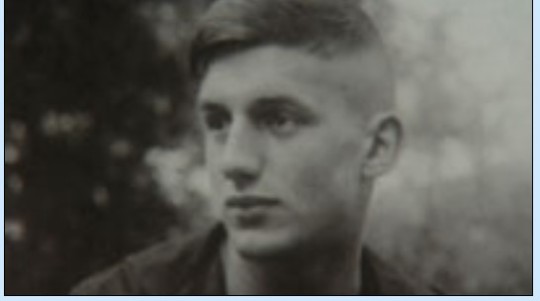
1906 – Albrecht Becker (d.2002) was a production designer, photographer, and actor, who was imprisoned by the Nazi regime for the charge of homosexuality.
Born in Thale, Germany, he trained as a teacher. At eighteen he began a relationship with an older man that lasted ten years. He was an actor and production designer. His partner was the Director of the State Archive in Würzburg. Through this contact he met an array of influential and artistic people. He traveled around the world and developed a lsense of culture and sophistication.
He devoted himself completely to photography. While living in Freiburg and Vienna he showed his first exhibitions and earned his first commissions. He supplemented his income by providing photographs for newspapers and magazines.
Würzburg is a small town in the southern state of Bavaria. Living in Würzburg in the 1930s was a Jewish wine merchant by the name of Dr. Leopold Obermayer. Obermayer apparently complained to the local police department that his mail was being opened. The complaint was investigated by the Gestapo, who took the liberty to search Obermayer's home and discovered a number of photographs of young men in his safe. One of these photographs was of Albrecht Becker. Becker was brought in for questioning in 1935 on suspicion of violating Paragraph 175. Becker reportedly declared: "Everybody knows I'm a homosexual." Both Obermayer and Becker were put on trial. Becker was sentenced to three years in prison at Nürnberg. Obermayer was also convicted of violating Paragraph 175, but as a Jew was sent to Dachau. He was tortured there and sent to Mauthausen, where he died.
Towards the end of the war as the need to replace losses increased Becker was released in order to serve in the Wehrmacht. He served on the Russian front until 1944. Becker spoke of his experiences during the war in the 2000 documentary Paragraph 175.


1908 – (Joseph Raymond) Joe McCarthy (d.1957) was an American politician who served as a Republican U.S. Senator from the state of Wisconsin from 1947 until his death in 1957. Beginning in 1950, McCarthy became the most visible public face of a period in which Cold War tensions fueled fears of widespread Communist subversion. He was noted for making claims that there were large numbers of Communists and Soviet spies and sympathizers inside the United States federal government and elsewhere. Homosexuals were particularly suspect of Communistic leanings.
McCarthy made accusations of Communist infiltration into the State Department, the administration of President Harry S. Truman, Voice of America, and the United States Army. He also used charges of communism, communist sympathies, or disloyalty to attack a number of politicians and other individuals inside and outside of government. Thousands of careers and lives were destroyed by his wild accusations
For a time, he was one of the most feared - and hated - men in America.
With the highly publicized Army-McCarthy hearings of 1954, McCarthy's support and popularity began to fade. On December 2, 1954, the Senate voted to censure Senator McCarthy by a vote of 67 to 22, making him one of the few senators ever to be disciplined in this fashion. McCarthy died in Bethesda Naval Hospital on May 2, 1957, at the age of 48. The official cause of death was acute hepatitis; it is widely accepted that this was exacerbated by alcoholism. There is no substance to the rumor the he, himself, was homosexual.
The term McCarthyism, coined in 1950 in reference to McCarthy's practices of demagoguery, baseless defamation, and mudslinging, was soon applied to similar anti-communist activities. Today the term is used more generally in reference to demagogic, reckless, and unsubstantiated accusations, as well as public attacks on the character and/or patriotism of political opponents.

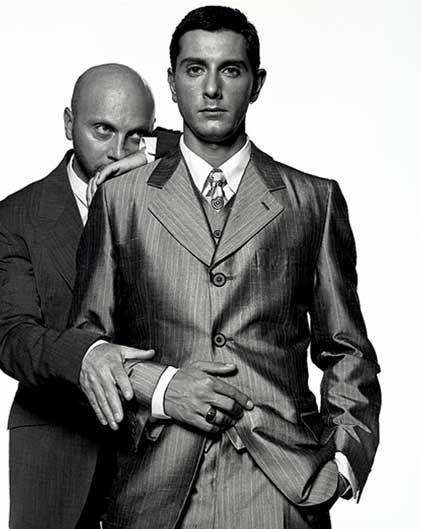
Stefano Gabbana (front) & Domenico Dolce
1962 – Born: Stefano Gabbana, co-founder of the Dolce and Gabbana fashion house, known for their sexy, glamorous women's clothing and sharp men's tailoring, all of which embody a distinctively southern Italian feel. Domenico Dolce's native island of Sicily, a place Gabbana had fallen in love with on holiday, became the bond between the two when they met in the early 1980s, when they worked for the same design studio in Milan.
Stefano Gabbana was born in Milan on November 14, 1962. Initially he went to art school to study graphics but soon transferred to fashion. In 1982 the two men left the design company where they were working when they met to pursue separate consulting careers, but they continued to share an office as well as a private life. After eighteen months, they decided to join forces and the Dolce & Gabbana label was born.
For some 19 years, Domenico Dolce and Stefano Gabbana were partners in life as well as in business. Their personal relationship, which commenced soon after their meeting in the early 1980s, was well documented and they spoke freely about their home life as well as their business partnership in interviews.
Their clothes for men mix the same key elements of sexiness and traditional detail as do their womenswear collections. Just as they put women in "men's clothes," so they mix traditionally masculine elements such as the white singlet (much loved and worn by gay men in the summer of 1995) and pin-striped suits with overtly feminine designs in bright colors.
"It has nothing to do with sexuality or being gay," Dolce told The Guardian Weekend magazine, "It's just that we all have this side ... It's today's society that has made men and women so different. It's good to search inside and discover this small part of the other sex which is inside you."
Dolce & Gabbana's clothes are worn by a whole host of celebrities: Tom Cruise, Brian Ferry, Brad Pitt, Bruce Willis, Isabella Rossellini, Demi Moore, and Nicole Kidman, to name but a few. They are known for donating clothes to and designing for stars they like. To those they do not like, they say "there is a shop."
By far their favorite celebrity is Madonna. "We love Madonna, so anything she asks we say yes, because we love the person, the style, the music--everything." Their admiration for Madonna is fully reciprocated. She is a very big fan of the duo, who are known in America as "the Italian designers"; she acknowledged their place in Italian culture when she stated "Now that Fellini, Rossellini, Pasolini and Visconti are gone, all we have is Dolce & Gabbana's neorealistic fashion."
In February 2005 Dolce and Gabbana broke up as lovers. According to Gabbana, they "had been drifting apart for about five years" prior to the split. The two remain friends and are still working together. Both say that they are committed to the ongoing success of their fashion house and that they plan to remain partners in the business even though they are no longer together as a couple.


1978 - Zoltan Voros (variously known as Zoltán Vörös, Zolival Vörös and Zoli Vörös) – is a leading Hungarian bodybuilder and occasionally a model. His regular occupation is security guard. Voros’ trainer is László Mazaga. According to both Polish Wikipedia and also the LGBT blog Fabulous Rainbow Stars, he is homosexual. He’s currently one of a few gay bodybuilders in Europe.

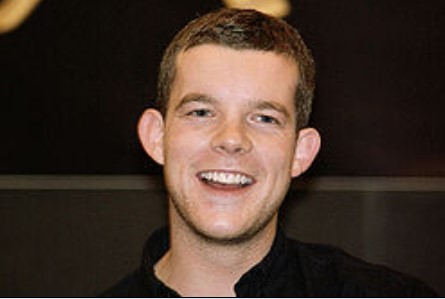
1981 – Russell Tovey is an English actor with numerous television, film and stage credits. Tovey is known for playing the role of werewolf George Sands in the BBC's supernatural drama Being Human which started in 2008. In November 2011, Tovey announced he would be leaving Being Human to work full-time on his BBC Three sitcom, Him & Her. Tovey is also known for his portrayal of the character of Rudge in both the original London and Broadway stage version, and later the film, of The History Boys.
Tovey is gay. He says he came out to himself when he was 15 or 16, and to his parents when he was 18. Tovey and his father had a falling out over Tovey's homosexuality, and his father suggested that, had he known earlier, he would have asked Tovey to take hormones or undergo some other medical treatment to "fix the problem". Tovey says his parents were deeply concerned about the possibility he might contract HIV, which may have contributed to the falling out. The birth of Tovey's nephew in 2005 helped them mend their relationship.
In an interview with The Scotsman, Tovey said,
"The only thing I can give to young gay people is that when I was growing up there were no role models that were blokey, that were men. Everybody was flamboyant and camp, and I remember going, 'That's not me, so even though I think I am gay, I don't think I fit into this world.'"
In 2015, Tovey was the subject of public criticism from the LGBT+ press regarding comments he made about effeminate gay men. In his interview with Tom Lamont of The Observer, the actor stated that his schooling made him feel as though he "had to toughen up", going on to say "If I'd have been able to relax, prance around and sing in the street, I might be a different person now." Much of the criticism centered on what was perceived to be a passive criticism of effeminate gay men, with Tovey saying that "I thank my dad for that, for not allowing me to go down the path." Tovey later apologized for the remarks.
Tovey was reported to be dating rugby coach Steve Brockman from early 2016. They became engaged in February 2018 but separated in June of the same year. They reconciled in August 2019 and, as of 2022, are still together.

Russell Tovey (R) and Steve Brockmann


1986 – Andy Herren is an American part-time adjunct professor of public speaking, most notable for winning the fifteenth season of the American reality television show Big Brother 15 (U.S.) in 2013. He is also the first openly gay winner in the show's history.
Andy won Big Brother 15 by a vote of 7-2 on finale night, only not receiving votes from Aaryn and Judd, becoming the first openly gay houseguest to win Big Brother.

1994 – China determines that same-sex acts are no longer to be considered a "social order" offense.


8 notes
·
View notes
Text
The Stuff I Read in June/July 2023
Stuff I Extra Liked is Bold
I forgot to do it last month so you get a double feature
Books
Ninefox Gambit, Yoon Ha Lee
Heteropessimism (Essay Cluster)
The Biological Mind, Justin Garson (2015) Ch. 5-7
Sacred and Terrible Air, Robert Kurvitz
Wage Labour and Capital, Karl Marx
Short Fiction
Beware the Bite of the Were-Lesbian (zine), H. C. Guinevere
Childhood Homes (and why we hate them) by qrowscant (itch.io)
piele by slugzuki (itch.io)
بچهای که شکل گربه میکشید، لافکادیو هرن
بچه های که یخ نزدند، ماکسیم گورکی
پسرکی در تعقیب تبهکار، ویلیام آیریش
Küçük Kara Balık, Samed Behrengi
Phil Mind
The Hornswoggle Problem, Patricia Churchland, Journal of Consciousness Studies 3.5-6 (1996): 402-408
What is it Like to be a Bat? Thomas Nagel, (https://doi.org/10.4159/harvard.9780674594623.c15)
Epiphenomenal Qualia, Frank Jackson, Consciousness and emotion in cognitive science. Routledge, 1998. 197-206
Why You Can’t Make a Computer that Feels Pain, Daniel Dennett, Synthese, vol. 38, no. 3, 1978, pp. 415–56
Where Am I? Daniel Dennett
Can Machines Think? Daniel Dennett
Divided Minds and the Nature of Persons, Derek Parfit (https://doi.org/10.1002/9781118922590.ch8)
The Extended Mind, Andy Clark & David Chalmers, Analysis 58, no. 1 (1998): 7–19
Uploading: A Philosophical Analysis, David Chalmers (https://doi.org/10.1002/9781118736302.ch6)
If You Upload, Will You Survive? Joseph Corabi & Susan Schneider (https://doi.org/10.1002/9781118736302.ch8)
If You Can’t Make One, You Don’t Know How It Works, Fred Dretske (https://doi.org/10.1111/j.1475-4975.1994.tb00299.x)
Computing Machinery and Intelligence, Alan Turing
Minds, Brains, and Programs, John Searle (https://doi.org/10.1017/S0140525X00005756)
What is it Like to Have a Gender Identity? Florence Ashley (https://doi.org/10.1093/mind/fzac071)
Climbing towards NLU: On Meaning, Form, and Understanding in the Age of Data, Emily M. Bender & Alexander Koller (10.18653/v1/2020.acl-main.463)
On the Dangers of Stochastic Parrots: Can Language Models Be Too Big? 🦜 Emily M. Bender et al. (https://doi.org/10.1145/3442188.3445922)
The Great White Robot God, David Golumbia
Superintelligence: The Idea that Eats Smart People, Maciej Ceglowski
Misc. Articles
Ebb and Flow of Azeri and Persian in Iran: A Longitudinal Study in the City of Zanjan, Hamed Zandi (https://doi.org/10.1515/9783110694277-007)
WTF is Happening? An Overview – Watching the World Go Bye, Eliot Jacobson
Using loophole, Seward County seizes millions from motorists without convicting them of crimes, Natalia Alamdari
Punks, Bulldaggers, and Welfare Queens, Cathy J. Cohen, Feminist Theory Reader. Routledge, 2020. 311-323
Is the Rectum a Grave? Leo Bersani (https://doi.org/10.2307/3397574)
Why Petroleum Did Not Save the Whales, Richard York (https://doi.org/10.1177/2378023117739217)
‘Spider-Verse’ Animation: Four Artists on Making the Sequel, Chris Lee
Carbon dioxide removal is not a current climate solution, David T. Ho (https://doi.org/10.1038/d41586-023-00953-x)
Fights, beatings and a birth: Videos smuggled out of L.A. jails reveal violence, neglect, Keri Blakinger
Capitalism’s Court Jester: Slavoj Žižek, Gabriel Rockhill
The Tyranny of Structurelessness, Jo Freeman
Domenico Losurdo interviewed about Friedrich Nietzsche
Keeping Some of the Lights On: Redefining Energy Security, Kris De Decker
Gays, Crossdressers, and Emos: Nonormative Masculinities in Militarized Iraq, Achim Rohde
On the Concept of History, Walter Benjamin
Our Technology, Zeyad el Nabolsy
Towards a Historiography of Gundam’s One Year War, Ian Gregory
Imperialism and the Transformation of Values into Prices, Torkil Lauesen & Zak Cope
#reading prog#one day i will be able to read books well again#most of the things that aren't linked i can provide directly upon request#those dennett citations are hard to track down
18 notes
·
View notes
Video
youtube
Friedrich Schneider (1786-1853) - Overture No. 4 in C Minor, Op. 45 "The Tragic" ·
Anhaltische Philharmonie Dessau · Markus L. Frank
4 notes
·
View notes
Note
What do you know about the parents of rammguys?
Not much. I never did very extensive research on the boys' parents. I only know what I could read right and left.
Till's parents are Werner (07.10.1926 - 09.02.1993) and Gitta (11.04.1939). Werner was born in Wolfen about 50km north of Leipzig (where Till was born). Werner's mother was called Siegfried, alias Ziggy, and adored her grandson who returned it well. She made pasta for the boys from Rammstein when they came to Leipzig. Gitta was a journalist, her job sent her all over GDR, so the family moved quite often, until she stopped in Rostock. Werner was a children's writer. He and Gitta lived separately, she in Rostock and he in Wendisch Rambow. Werner died in 1993 in Zickhusen. Till has a sister six years younger than him, Saskia.
Schneider's parents were accomplished music lovers. His dad, Martin Schneider (17.03.1938 - 22.01.2021) was an opera director and university professor. Little Christoph learned to play the piano very early. He also learned to play trumpet in a music school and to play in an orchestra. Then his parents moved away and Schneider, against their will, wanted to start the drums. He had made a drumset himself before he could buy a real set. Faced with the "fait accompli", his parents allowed him to continue and take lessons. I don't know anything about his mom. Christoph has a sister two years younger than him.
Paul's parents are Anton and Erika Hiersche. Anton (born in 1934) was born in present-day Czech Republic and Erika was born in East Prussia, present-day Poland. Both had to flee their countries during the Second World War and settled in the GDR. Both are Slavists and described as fervent socialists. When Paul was eight years old and his sister eleven years old, they left with their mother to settle in Moscow because she was giving conferences at the University. They stayed there for a year before returning to Berlin.
Flake was born, raised and still lives in Prenzlauer Berg in Berlin. His father was an engineer at the VEB Elektro-Apparate-Werke Berlin-Treptow "Friedrich Ebert" (EAW) and his mother was an academic and a journalist. He is an excellent pianist and chose to play this instrument because one of his childhood friends played it from the age of three. His parents therefore sent him to a music school. Flake has a brother three years older than him, Auge, who is a writer and cartoonist (his Instagram if you want to see his work).
Ollie was born to very young parents and describes them more as friends than parents. He always had a good relationship with them. They were music lovers, his mother listened a lot to Bob Dylan. Oliver was very bad at school, and his mother thought it was because the teachers were bad, so she let him do sports instead of his homework. Ollie describes his childhood as normal and says he was extremely shy. He has no brother or sister. And according to Flake, he started the bass because in his first band there were already guitarists so they put a bass in his hands and said to play : "Supposedly it’s a trademark of bass players that they’re easygoing and play their stuff without saying much, but I don’t think it applies to him because I have heard that he actually wanted to be a guitarist, and only began to play bass because there was already a guitarist in his former band. A bass was pressed into his hand. Play that. I know that some bass players like to spend hours stoically playing a theme, but Olli is far too impatient for that, but I think that it's good because as a result he has ideas that wouldn’t come from the others. Whether these ideas are put into action is another story."
Richard was born in Wittenberg, he is the last of a sibling. He has two older sisters and a brother. He describes his early years as beautiful and carefree. But his parents' divorce shattered everything. Subsequently, his mother rebuilt her life and decided to take her children to live with her and her new companion. It is from there that life becomes difficult for Richard. He has a conflicted relationship with his stepfather. He speaks of a "difficult relationship" which led him to run away many times. During his runaways he sleeps in the street, on benches or takes refuge with friends, until the police bring him home. I don't know anything else about his parents.
If you have any other information, do not hesitate to complete these portraits or correct them.
40 notes
·
View notes
Note
hi i have a little 18th century german boy oc and u r the only german person ik . i want to strike a deal . if u suggest German names i will give u cat pictures
A lil 18th century German oc? Oh boy oh boy those dudes had terrible names like Gerhard, Eberhard, Reinhard…lots of hard huh…
But here are a few German names (also a bit Nordic, cuz I’m a bitch living in the north and c’mon Hanse <33) which I believe to be rather timeless and free of the grandpa stamp:
-Hans
-Erik (also Eric)
-Anton
-Till
-Emil
-Mats
-Fiete
-Lars / Lasse
-Konrad (also Conrad)
-Fred
-Moritz
-Jannik (also Jannick, Yannic, Yannik, Yannick…)
-Gustaf (also Gustav)
-Arne
-Phillip (also Fillip)
-Finn
-Jakob
-Jan
-Nils
-Julius
(Not me searching through my followers on insta to look up my classmate’s names…👹)
Those would be a few that come to mind when I think of timeless names that guys had in the 18th century and today. When we think about 18th century people specifically, I just think of writers and artists of that time, like:
Johann Wolfgang von Goethe (<3) and his boyfriend
Friedrich Schiller,
Gotthold Ephraim Lessing,
Joseph von Eichendorff (<3),
Caspar David Friedrich (<3),
Heinrich Reinhold…etc. etc…
As most last names, Germany’s last names are an indicator for the occupation someone had (unless there’s a von, that means they’re nObLe), here are some examples:
-Schmidt
-Weber (hehe)
-Bauer
-Müller / Möller
-Koch
-Schneider
-Fischer
-Meier/Meyer
-Wagner
-Becker
-Hoffmann
-Schäfer
-Wolf
-Neumann
-Zimmermann
-Krüger
-Köhler
Etc. etc….
NOW GIVE ME THE CAT PICS 🔫
31 notes
·
View notes
Note
what about celebrity crushes? For all the couples
Beth- Now, in my modern au, she is aro-ace, so any romantic or sexual crushes are out, but she definitely would have platonic crushes, and I think hers would be Nina Simone. Not only is she a musician that Beth looks up to, but just how Simone had overcome so many obstacles in her personal life, a civil rights activist among so many other things, makes Beth not only admire her but also try to be more outgoing. To her, Simone seemed like someone that Beth could talk and share so much with her, other than her family, and she often imagined Simone giving her encouraging words or playing the piano beside her like friends would.
Meg x John- I can see Meg having a crush on your typical crushes of the early 2000s, like Zac Efron in High School Musical or Ben Barnes as Prince Caspian. Even as the years have gone by, she she crushes hard on Ben Barnes, especially in The Punisher and Shadow and Bone. John has always had a thing for Kate Winslet after seeing her in Titanic. His classmates used to tease him for liking a “fat” actress (this is based on how the media viewed her), but he thought she was gorgeous. My face claim for Meg (x) reminds me a lot of Winslet in Titanic, so when he dates her, he considers himself a very lucky dude.
Jo x Friedrich- In a different post (x), I touched on Jo’s first crush, which was Atticus Finch from To Kill A Mockingbird. Once she sees the movie and finds out Gregory Peck is pretty much Atticus, she falls hard. Friedrich, given that he grew up in Europe, I see him crushing hard on Romy Schneider. He first saw her in the Sissi movies, where she was a free spirted brunette who has a bit of a tomboyish streak, which was how she pretty much was like in real life. Very clearly, these two had a type.
Amy x Teddy- You know the tweet that says your sexuality is determined the way God intended, by watching Labyrinth starring David Bowie and Jennifer Connelly? You know, this one? (x) Enough said.
#answered asks#little women#meg march#john brooke#meg x john#meg and john#jo march#jo and friedrich#jo x friedrich#amy march#theodore laurence#amy and laurie#amy x laurie#beth march#modern au#friedrich bhaer
18 notes
·
View notes
Text
THE 236 GREATEST PERSONALITIES IN THE ENTIRE KNOWN HISTORY/COLLECTIVE CONSCIOUSNESS OF THIS WORLD! (@INDIES)
i.e. THE 236 GREATEST PERSONALITIES IN WORLD HISTORY! (@INDIES)
Rajesh Khanna
Lionel Messi
Leonardo Da Vinci
Muhammad Ali
Joan of Arc
William Shakespeare
Vincent Van Gogh
Online Indie
J. K. Rowling
David Lean
Nadia Comaneci
Diego Maradona
Wolfgang Amadeus Mozart
Meena Kumari
Julius Caesar
Harrison Ford
Ludwig Van Beethoven
William W. Cargill
Fritz Hoffmann-La Roche
Samuel Curtis Johnson
Sam Walton
John D. Rockefeller
Andrew Carnegie
Roy Thomson
Tim Berners-Lee
Marie Curie
James J. Hill
Cornelius Vanderbilt
Roman Polanski
Samuel Slater
J. P. Morgan
Cary Grant
Dmitri Mendeleev
John Harvard
Alain Delon
Ramakrishna Paramhansa (Official God)
The Lumiere Brothers, Auguste & Louis
Carl Friedrich Benz
Michelangelo
Maharishi Mahesh Yogi
Ramana Maharishi
Mark Twain
Swami Sri Yukteswar Giri
Bruce Lee
Bhagwan Krishna (Official God)
Charlemagne
Rene Descartes
John F. Kennedy
Bhagwan Ganesha (Official God)
Walt Disney
Albert Einstein
Nikola Tesla
Alfred Hitchcock
Pythagoras
William Randolph Hearst
Cosimo de’ Medici
Johann Sebastian Bach
Alec Guinness
Nostradamus
Christopher Plummer
Archimedes
Jackie Chan
Guru Dutt
Amma Karunamayi/ Mata Parvati (Official God)
Peter Sellers
Gerard Depardieu
Joseph Safra
Robert Morris
Sean Connery
Petr Kellner
Aristotle Onassis
Usain Bolt
Jack Welch
Alfredo di Stefano
Elizabeth Taylor
Michael Jordan
Paul Muni
Steven Spielberg
Louis Pasteur
Ingrid Bergman
Norma Shearer
Dr. B. R. Ambedkar
Ayn Rand
Jesus Christ (Official God)
Luciano Pavarotti
Alain Resnais
Frank Sinatra
Allah (Official God)
Richard Nixon
Charlie Chaplin
Thomas Alva Edison
Alexander Graham Bell
Wright Brothers
Arjun (of Bhagwan Krishna’s Gita)
Jim Simons
George Lucas
Swami Sri Lahiri Mahasaya
Carl Lewis
Brett Favre
Helen Keller
Bernard Mannes Baruch
Buddha (Official God)
Hugh Grant
K. L. Saigal
Roger Federer
Rash Behari Bose
Tiger Woods
William Blake
Jesse Owens
Claude Miller
Bernardo Bertolucci
Subhash Chandra Bose
Satyajit Ray
Hippocrates
Chiang Kai-Shek
John Logie Baird
Geeta Dutt
Raphael (painter)
Bhagwan Shiva (Official God)
Radha (Ancient Krishna devotee)
George Orwell
Jorge Paulo Lemann
Catherine Deneuve
Pierre-Auguste Renoir
Bill Gates
Bhagwan Ram (Official God)
Michael Phelps
Michael Faraday
Audrey Hepburn
Dalai Lama
Grace Kelly
Mikhail Gorbachev
Vladimir Putin
Galileo Galilei
Gary Cooper
Roger Moore
John Huston
Blaise Pascal
Humphrey Bogart
Rudyard Kipling
Samuel Morse
Wayne Gretzky
Yogi Berra
Barry Levinson
Patrice Chereau (director)
Jerry Lewis
Louis Daguerre
James Watt
Henri Rousseau
Nikita Krushchev
Jack Dorsey
Dev Anand
Elia Kazan
Alexander Fleming
David Selznick
Frank Marshall
Viswanathan Anand
Major Dhyan Chand
Swami Vivekananda
Felix Rohatyn
Sam Spiegel
Anand Bakshi
Victor Hugo
Bhagwan Sri Sathya Sai Baba (Official God)
Steve Jobs
Srinivasa Ramanujam
Lord Hanuman
Stanley Kubrick
Giotto
Voltaire
Diego Velazquez
Ernest Hemingway
Francis Ford Coppola
Michael Douglas
Kirk Douglas
Mario Lemieux
Kishore Kumar
James Stewart
Douglas Fairbanks
Confucius
Babe Ruth
Raj Kapoor
Titian aka Tiziano Vecelli
El Greco
Francisco de Goya
Jim Carrey
Mohammad Rafi
Steffi Graf
Pele
Gustave Courbet
Rani Laxmibai of Jhansi
Milos Forman
Steve Wozniak
Georgia O’ Keeffe
Mala Sinha
Aryabhatta
Magic Johnson
Patanjali
Leo Tolstoy
Tansen
Henry Fonda
Albrecht Durer
Benazir Bhutto
Cal Ripken Jr
Samuel Goldwyn
Mumtaz (actress)
Panini
Nicolaus Copernicus
Pablo Picasso
George Clooney
Olivia de Havilland
Prem Chand
Imran Khan
Pete Sampras
Ratan Tata
Meerabai (16th c. Krishna devotee)
Queen Elizabeth II
Pope John Paul II
James Cameron
Jack Ma
Warren Buffett
Romy Schneider
C. V. Raman
Aung San Suu Kyi
Benjamin Netanyahu
Frank Capra
Michael Schumacher
Steve Forbes
Paramhansa Yogananda
Tom Hanks
Kamal Amrohi
Hans Holbein
Shammi Kapoor
Gerardus Mercator
Edith Piaf
Bhagwan Shirdi Sai Baba (Official God)
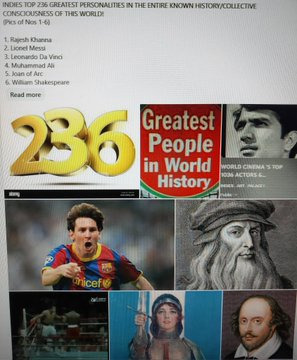


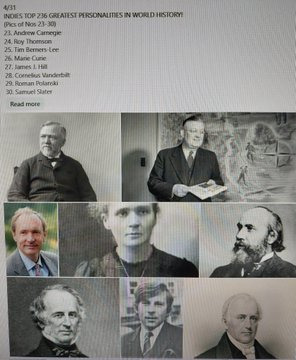
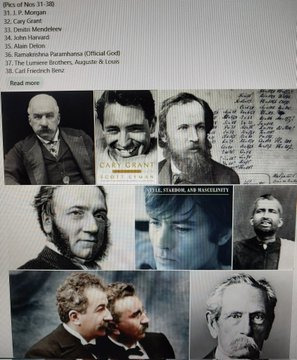
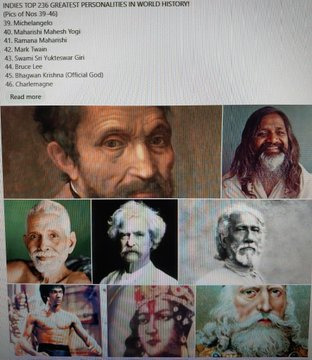
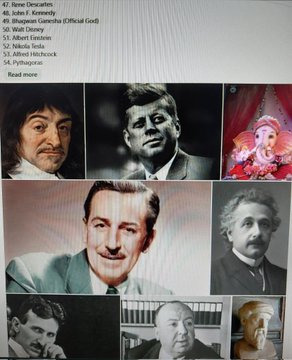

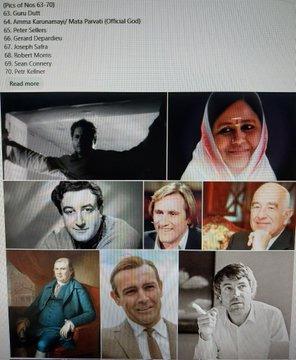



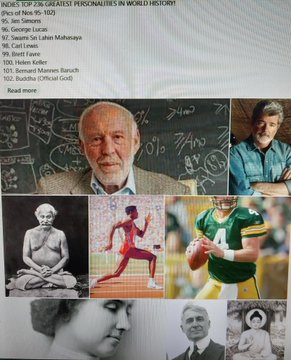
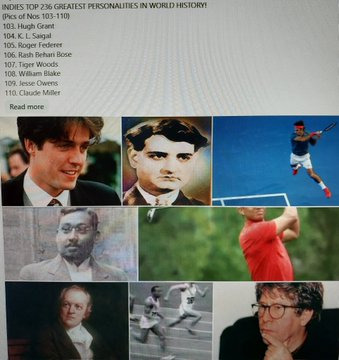
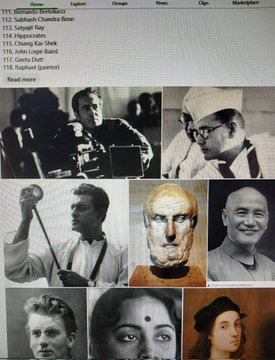

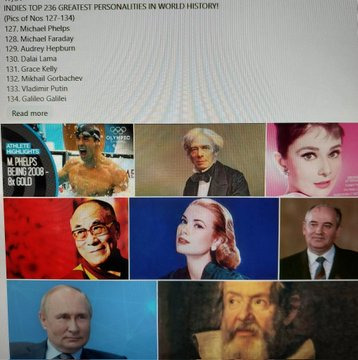

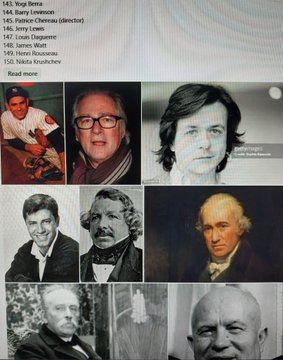
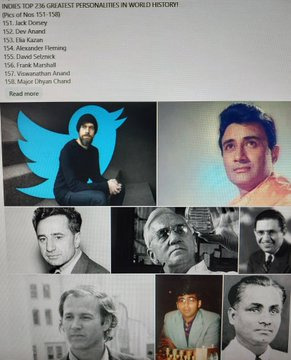
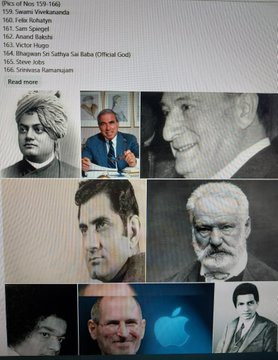
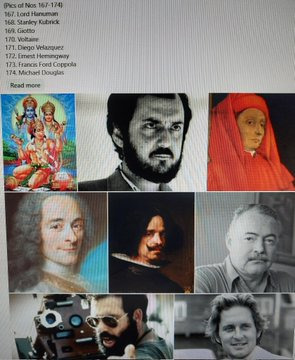
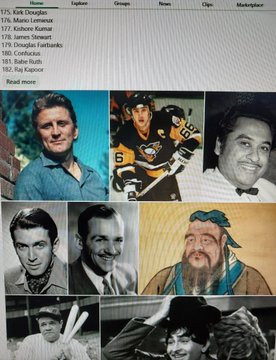
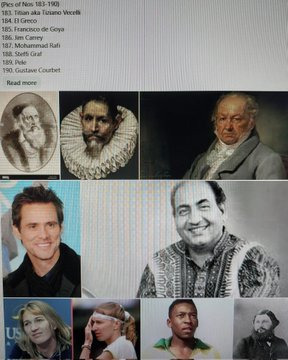
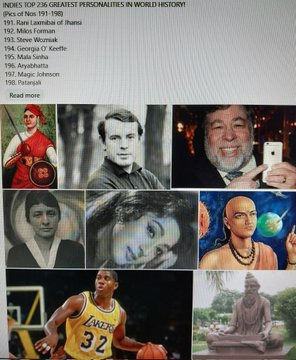
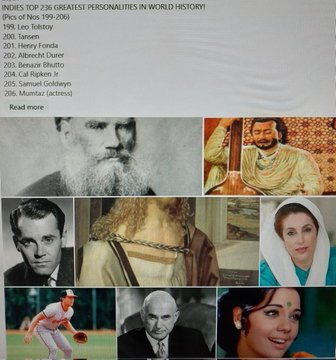

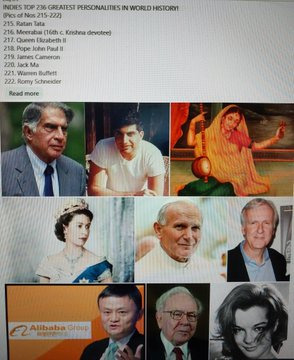

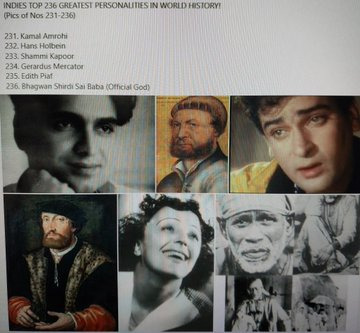
3 notes
·
View notes